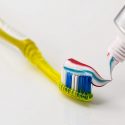Waterpik Vs Flossing For People With Braces
The intended end result of wearing braces is straight teeth and a winning smile. Unfortunately, without excellent oral health habits, braces can have other, unintended consequences, such as white marks on the teeth (i.e. decalcification) and gum disease (gingivitis). These are serious problems that can lead to lifelong oral health challenges.
In this article, we will compare and contrast flossing and use of a Waterpik in caring for teeth with braces. Can a Waterpik replace flossing with braces? Read on to learn more.
How Do Gingivitis And Decalcification Threaten Good Oral Health?
Good gum health is extremely important because the roots of your teeth are seated in your gums. If food particles and bacteria are not regularly removed, you will soon experience sore, swollen, inflamed gums. This is gingivitis, an early sign of serious gum disease.
Decalcification is also caused by a failure to keep teeth clean. It manifests as bleached pitting and white spots on the teeth. Once these lesions appear, they cannot be removed, so it is very important to be proactive in keeping teeth and braces clean to prevent permanent tooth damage.
Luckily, good oral hygiene is not complicated. It is just a matter of developing regular habits in care and maintenance. Brushing, flossing and using a Waterpik are keystones of a good oral maintenance program.
Special Techniques For Brushing And Flossing When You Have Braces
It’s important to brush several times a day when you have braces. After every snack and meal, you should brush and rinse thoroughly to remove food particles, plaque (an acidic, yellowish, decay causing film) and digestive acids from your braces and the surfaces of your teeth.
When you brush, be sure to use fluoridated toothpaste as this helps fight against decalcification. If you are not able to brush immediately, be sure to at least rinse your mouth thoroughly with warm water. Following up with a fluoridated rinse is also helpful.
In addition to frequent brushing, it’s a good idea to floss after eating. Some people like to use a floss threader to floss with braces. Others find this method tedious and time consuming. This appliance consists of a flexible loop that can be used to guide floss through small spaces in your braces in much the same way a needle threader can be used to guide thread through the eye of a needle.
The Waterpik Water Flosser Is An Easy Way To “Floss”
In addition to flossing with traditional floss, you may wish to invest in a Waterpik Water Flosser with Orthodontic Tip. This appliance has a tapered brush tip that accesses plaque stuck between teeth and under the brackets of your braces. The brush tip dislodges bacteria and debris and the water action rinses it away from teeth and gums.
Pros And Cons Of Dental Floss Vs. Waterpik
As with many choices in personal care and in life, the decision between Waterpik and floss is not really an “either/or” proposition. Both have their good points, and both have a place in good oral health care and care of teeth with braces.
Dental floss is effective, thrifty and portable. It is a good tool for reaching into tight spaces and scraping away plaque from the otherwise inaccessible sides of the teeth. It is also light and easy to carry in your purse or pocket for quick use as needed throughout the day.
On the downside, if you have sensitive gums flossing can cause irritation and bleeding. There are also certain areas in and behind braces where floss cannot reach. What to do?
A Waterpik Can Reach Places Floss Cannot
Using a Waterpik can stimulate your gums and contributes to good gum health. Regular use may help toughen up your gums so that you can tolerate flossing better. This appliance also helps address problems with gum disease by washing bacteria out of deep pockets in the gums surrounding the teeth.
The pressurised spray of water provided by this appliance can easily reach behind the brackets and metal wires of braces to wash away hidden particles of food. On the downside, a Waterpik cannot scrape plaque off teeth. For this you need to floss.
You Can (And Should) Have It All!
Clearly, there is a place for both flossing and use of a Waterpik in caring for teeth with braces. These two methods of oral hygiene care address different aspects of the process. Combined with regular brushing and regularly scheduled trips to the dentist and/or orthodontist, use of both methods will help keep teeth with braces clean, healthy and strong.
For the best results, you should brush and floss at least twice a day. Carry a dental care kit consisting of a toothbrush, fluoridated toothpaste and a roll of dental floss or floss picks with you at all times to keep your teeth and braces clean and your gums healthy.
At bedtime, brush and floss and use your Waterpik for its extra cleaning advantages and gum therapy value. This will ensure that you go to bed with completely clean teeth and braces, thus avoiding the development of cavities, decalcification and gingivitis while you sleep.
Going to bed with a clean mouth is very important because the body produces less saliva during sleep. Saliva has antibacterial properties that help defend teeth and gums against plaque buildup, digestive acid damage and gum disease.
This is why your bedtime brushing routine should be thorough and consistent. Be sure to brush your teeth thoroughly for at least two minutes. Brush your tongue, too! Floss thoroughly and then use your Waterpik (or another type of a water flosser) to wash away the bacteria and debris flossing has dislodged, along with anything that may be lurking beneath your braces.
While it may seem as if all these steps could be time consuming, the fact is once you get into a routine you should be able to finish up in 5-7 minutes. The return on this small investment of time is tremendous: straight healthy teeth, healthy gums, fresh breath and freedom from periodontal disease and the myriad health complications that come with it.




